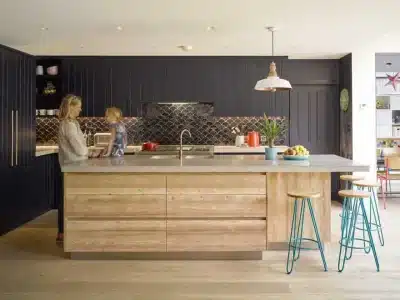Washbasin, washbowl, washstand, sink – call it what you will, but that thing you use to wash your hands and face and brush your teeth every day is one of the ‘holy trinity’ of bathroom fixtures. When it comes to redesigning and refitting your bathroom, choosing your washbasin, along with the bath/shower and toilet, is one of the key decisions you will have to make.
And, according to designer bathroom specialists, it’s the decision where you arguably have the greatest freedom in terms of the choices on offer. Because they are much smaller than baths, sinks can be made in a much broader range of shapes and styles, with numerous installation options to boot. Toilets, meanwhile, are restricted by the mechanical needs of the cistern and flush.
Choice is great, but it also brings its own challenges – namely, narrowing down all the possibilities and actually picking out ‘the one’. So how do you go about choosing the right sink for your bathroom?
Washbasins are categorised by the way they are mounted. Let’s take a whirlwind tour through the main options available, highlighting the pros and cons of each to help you on your way.
Choosing by type of installation
The way your washbasin is mounted or installed gets right to the crux of the decisions you have to make when refitting your bathroom. With a bath, you basically have two choices – a built-in bath or a freestanding tub, and which you go far is often dictated by budget, space and how much work you want to do running the plumbing to somewhere funky.
With a sink, you get a lot more options within the same price brackets, knowing full well that all the units on offer can more or less be installed in the same space. That means the choice often depends on little more than taste and aesthetic preference, with a few small practical considerations thrown in. Here’s a brief overview of the main types.
Pedestal sink
Also known as a freestanding washbasin, this is a classic and common option. The whole thing, the sink and the stand, come as one independent piece, making installation easy and cost effective. The pedestal is also a convenient way to hide away pipes, if that is a concern. To some people, the column/pedestal on which the basin sinks gets in the way, taking up precious space that could be used in other ways (e.g. storage or hanging towels). On the other hand, a freestanding sink is probably your only option for positioning your washbasin away from the wall, if you want to break with that particular tradition.
Built-in basin
The name says it all – the washbasin is built into a separate support of some kind, whether that is a cabinet or a tabletop. Unlike a pedestal sink, you are not really buying an all-in-one unit, basin and stand. Even when bathroom vendors list complete ‘washstands’ or sinks ready mounted onto a piece of furniture, you are paying extra for it.
Built-in basins therefore tend to be more of premium-priced option, but they might also be considered a luxury option to boot. A built-in washbasin is an opportunity to really make a statement with a beautiful piece of furniture in your bathroom. There is also a practical benefit – certainly with a cabinet, or even with an open stand with shelving underneath, a built-in configuration can provide valuable storage space under the basin itself.
Most built-in sinks are fitted by dropping the basin into a pre-cut hole from above, which leaves a rim above the counter surface. Another option, sometimes preferred as a more sleek, premium design, is a so-called undermount basin, which, as the name hints, is installed from underneath the unit to sit flush with the surrounding surface.
Tabletop sink
The table or countertop style is similar to the built-in variety in as much as it involves a separate basin and a supporting piece of furniture underneath. The main distinction is that a tabletop is fitted to sit on a surface, rather than being built into it by cutting a hole. This makes a tabletop basin easier to fit, which is particularly useful if you have your eye on a dream bathroom cabinet or stand and want to pair it with a washbowl without doing major surgery to the tabletop.
Moreover, the added freedom and flexibility of installation tends to mean you can be a little more creative with the style and shape of a countertop basin than you can be with any other variety. Nevermind the cabinet beneath – if you want to make a statement with an irregularly shaped stone bowl, you would be best opting for a countertop. They are also frequently designed to be ‘bowl only’, with no room for tap fittings (i.e. just a plug hole in the bottom). This also appeals to people looking for very clean, minimalist look, with the option to fit faucets into the wall.
Wall-hung washbasin
You’ve probably noticed by now that the names of these sink types do a pretty good job in describing how they are installed. The wall-hung type is no different – it’s a type of washbasin that fits directly to a wall, rather than to a stand of some kind. The main benefit of this ‘floating’ look is that it opens up the space underneath the basin completely, which you might choose to put to some other practical use, or just leave as it is to create a roomier feel.
The drawback for some people is that a wall-mounted basin will inevitably leave exposed pipework. For others, that can become a design feature in itself, especially if you don’t mind splashing out for stylish fittings.
Console sink
Finally, a console sink is somewhere in the middle of the pedestal and wall-mounted varieties. It is essentially a washbasin on its own integrated stand, but unlike the pedestal type, the supports take the form of slim table-like legs fitted to the corners of the sink, rather than a large central column. This means that, like the wall-hung type, you get the benefit of open space underneath. Many consoles are also fitted to the wall in some way, either via brackets that form part of the supporting frame, or the rear part of the basin itself. Others come as free-standing, fully integrated units.
Consoles are often considered a great choice for a more traditional bathroom design – certainly the combination of a white porcelain bowl and chrome stand is a classic look.
















